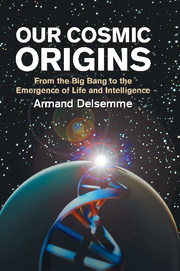Book contents
- Frontmatter
- Contents
- Foreword
- Preface
- Acknowledgments
- 1 Locating humans in the Universe
- 2 The race toward complexity
- 3 The stellar alchemy of metals
- 4 The formation of the planets
- 5 The emergence of life
- 6 The history of life
- 7 The awakening of intelligence
- 8 The other worlds
- 9 Perspectives
- APPENDIX A The standard model of the physics of elementary particles
- APPENDIX B Symmetry in physics
- APPENDIX C The strange role of time in relativity
- APPENDIX D The measurement of long time spans and the age of the Universe
- APPENDIX E The standard model of the Big Bang
- APPENDIX F The cause of the Big Bang and inflation
- APPENDIX G Chirality
- Glossary
- Bibliography
- Figure index
- Table index
- Name index
- Subject index
6 - The history of life
Published online by Cambridge University Press: 05 August 2012
- Frontmatter
- Contents
- Foreword
- Preface
- Acknowledgments
- 1 Locating humans in the Universe
- 2 The race toward complexity
- 3 The stellar alchemy of metals
- 4 The formation of the planets
- 5 The emergence of life
- 6 The history of life
- 7 The awakening of intelligence
- 8 The other worlds
- 9 Perspectives
- APPENDIX A The standard model of the physics of elementary particles
- APPENDIX B Symmetry in physics
- APPENDIX C The strange role of time in relativity
- APPENDIX D The measurement of long time spans and the age of the Universe
- APPENDIX E The standard model of the Big Bang
- APPENDIX F The cause of the Big Bang and inflation
- APPENDIX G Chirality
- Glossary
- Bibliography
- Figure index
- Table index
- Name index
- Subject index
Summary
All living organisms develop from germs, that is to say, they owe their origins to other living beings. But how did the first living things arise?
A. I. Oparin, 1924 (quoted in Origins of Life, ed. D. W. Deamer and G. R. Fleischacker 1994)The primordial Earth
Four and a half billion years ago, the proto-Earth was completing its formation. During the last accretion phases, its growing gravity had increased the impact velocities, so that their energies had been transformed into more and more heat. Hence the proto-Earth became progressively covered with a thick layer of molten lava, possibly to a very great depth.
The large-scale differentiation that separated the denser iron core from the mantle of lighter silicates was triggered by this intense heat. The last large impact occurred somewhat later, notably the one which, by a tangential grazing collision, caused the appearance of a transient ring around the Earth that rapidly became the Moon. The smaller cometary impacts, however, persisted and ended by establishing, not only the atmosphere and the oceans, but also the minor differentiation that separated the terrestrial crust from the underlying mantle.
The chemical and isotopic evidence that the terrestrial crust formed so early on was an enigma for geologists. It seems to be resolved by the cometary bombardment, when chondritic silicates were plowed deeply into the surface of the Earth after the separation of the core from the mantle.
- Type
- Chapter
- Information
- Our Cosmic OriginsFrom the Big Bang to the Emergence of Life and Intelligence, pp. 155 - 194Publisher: Cambridge University PressPrint publication year: 1998

